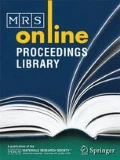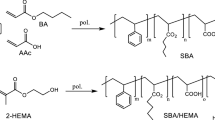Abstract
Organic/inorganic (O/I) composite latexes combine the best attributes of inorganic solids with the processability, lightweight and handling advantages of organic polymers. There are common methods to produce polymer nanocomposites: melt compounding, in-situ polymerization and solution mixing. Emulsion polymerization is an unique chemical process widely used to produce waterborne resins with various colloidal and physicochemical properties. This free radical polymerization process involves emulsification of the relatively hydrophobic monomer in water by an oil-in-water emulsifier, followed by the initiation reaction with a water insoluble initiator. This research focuses on the synthesis and reactions kinetics of polyacrylic latex with the incorporation of various nanospheres (SiO2, TiO2, Al2O3 and Fe2O3), and layered silicate (Bentonite nanoclay) nanoparticles via emulsion polymerization. The influence of nanoparticle concentration on reaction kinetics was also investigated. The results showed that the concentration of nanoparticles has significant influence on the monomer conversion, particle size, coagulum content and viscosity of the emulsion. Furthermore, the nanostructured emulsions were shear thinning, exhibiting a power-law behavior, and the viscosity was influenced by the nanoparticle morphology.
Similar content being viewed by others
References
C. Chorng-Shyan, Principles and applications of emulsion polymerization, (John Wiley & Sons, Inc., Hoboken, New Jersey, USA, 2008).
T. Provder and J. Baghdachi, Smart Coatings, (Eds. ACS Symposium Series 957; American Chemical Society: Washington, DC, 2007).
M.L. Hernández-Vargas, C. Valerio-Cárdenas and A. Romo-Uribe, ACS Polymer Chemistry Proceedings (2011).
E. Bourgeat-Lami and M. Lansalot, Adv. Polym. Sci. 233, 53 (2010).
C.S. Chern, Prog. Polym. Sci. 31, 443 (2006).
P. Meneghetti and S. Qutubuddin, Langmuir. 20, 3424 (2004).
X. Huang and W.J. Brittain, Macromolecules. 34, 3255 (2001).
A. Einstein, Ann. Phys. (Leipzing). 19, 371 (1906).
Acknowledgements
ML Hernández-Vargas was supported by graduate scholarship from the Mexican Council for Science and Technology (CONACyT). This research was supported by DGAPA-UNAM under PAPIIT program, grant IN118514.
Author information
Authors and Affiliations
Corresponding author
Rights and permissions
About this article
Cite this article
Hernandez-Vargas, M.L., Romo-Uribe, A. & Baghdachi, J. Influence of nanoparticle morphology on reaction kinetics, particle size and rheology in acrylic latex. MRS Online Proceedings Library 1767, 17–22 (2015). https://doi.org/10.1557/opl.2015.222
Published:
Issue Date:
DOI: https://doi.org/10.1557/opl.2015.222




